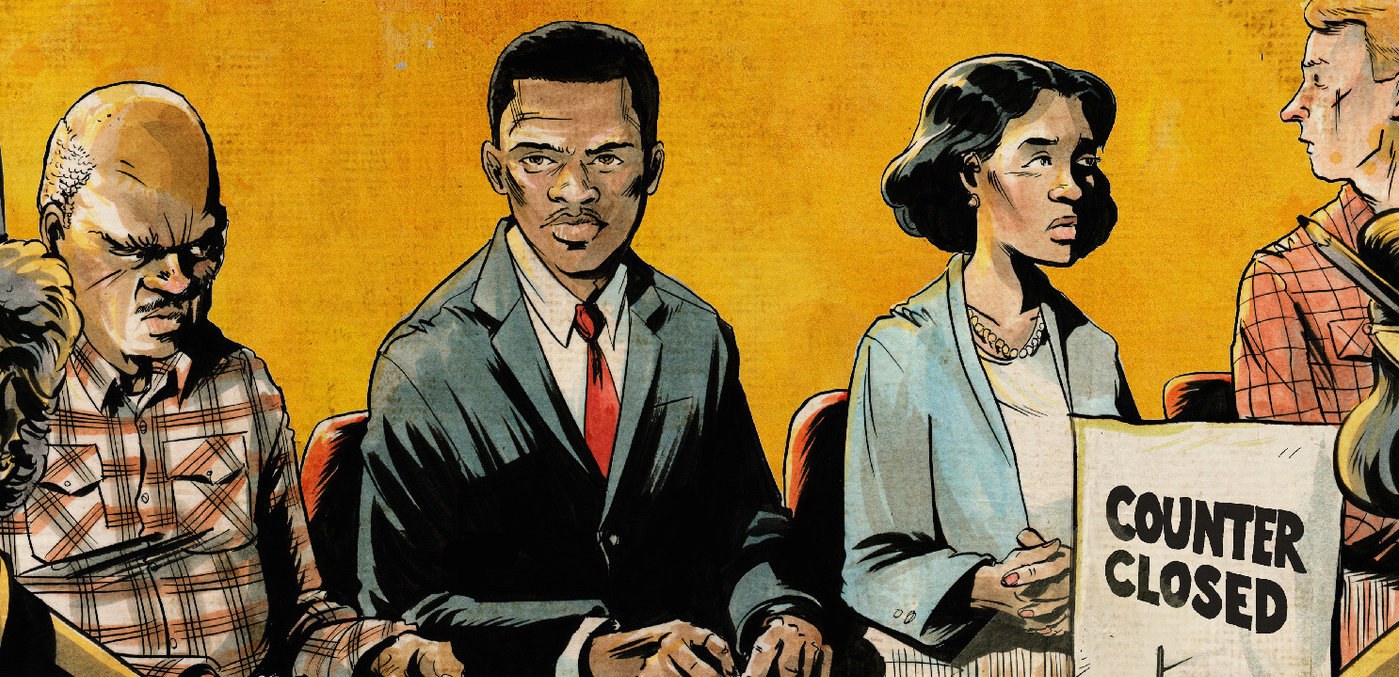Earlier today, we shed light on the New York Times’ decision to eliminate the comics and manga bestseller lists, among others, from their Book Review. After the report, many questions remained about their motivations and the place of comics at the Times moving forward.
When asked for comment on why specific lists, including those related to comics and manga, were removed, the Times said that “the discontinued lists did not reach or resonate with many readers. This change allows us to expand our coverage of these books in ways that we think will better serve readers and attract new audiences to the genres.”
The silver lining to this change is that “genres related to the discontinued lists will be included in the
relevant remaining lists.” In other words, it is still possible for comics like Smile to rank in the Bestseller lists. However, it will be much harder than it was before.
Ultimately, it appears that the policy change is financially motivated. However, why genre lists such as comics, YA, and mass market paperbacks were all targeted while other niche sections remain is still unclear.
A source indicated to The Beat that Pamela Paul, editor of the New York Times Book Review, was ultimately responsible for the policy shift. A recent tweet about John Lewis’, Andrew Aydin’s, and Nate Powell’s March began with “hey, kids” and called the comic a “children’s book.”
Hey, kids: The new children’s book by @repjohnlewis has set an awards record https://t.co/0bB1t46joI
— Pamela Paul (@PamelaPaulNYT) January 24, 2017
Update: Pamela Paul has tweeted regarding the Book Review’s changes in comics coverage:
Quick note to fellow comics/graphic novel fans: The Times is not cutting back on coverage of these genres/formats but rather…. 1/2
— Pamela Paul (@PamelaPaulNYT) January 26, 2017
…expanding on coverage in ways that reach more readers than the lists did. To wit: new graphic reviews by comic artists, more reviews 2/3
— Pamela Paul (@PamelaPaulNYT) January 26, 2017
…and more news and features about then genre and it’s creators. We are big fans, and want to recognize growing readership. Stay tuned. 3/3
— Pamela Paul (@PamelaPaulNYT) January 26, 2017
While the message and the willingness to engage are certainly positive signs, some complicated issues remain in play. The fact that comics had a bestseller list devoted to them was a symbolic sign of the medium’s importance to one of the nation’s most respectable media outlets and their importance to the nation at large. Moreover, there are few stronger marketing loglines than “New York Times bestseller.” While the Times is foremost a media outlet and not a marketing firm, the way their endorsements affect sales and popular discourse cannot be ignored. The decision to eliminate these lists will have implications for our conversations and our bottom lines.








Calling “March” a “children’s book” is so demoralizing and condescending.
The YA list was created after Harry Potter dominated the mainstream lists 10+ years ago. IIRC the comic list was also broken out after something, sandman maybe?, reared its unwanted head among the serious books.
It was a way to ghettoise these genres so the Times’ real bestseller lists were kept free of them.
I imagine the Times decided it does not want to do the weekly work of keeping additional lists just to lock out outliers like Harry Potter anymore.
Olds still stigmatize comics. Cutting their bestseller list from a newspaper says more about newspapers than it does about comics.
@Kid Kyoto: There may very well have been an effort to ghettoize comics away from the “serious” lists, but I don’t Sandman would have been the catalyst since the first lists were published in 2009, a year that was not particularly Sandman-ish.
https://artsbeat.blogs.nytimes.com/2009/03/05/introducing-the-new-york-times-graphic-books-best-seller-lists/?_r=0
“Moreover, there are few stronger marketing loglines than “New York Times bestseller.” ”
Oh, yeah, comics shops really marketed the heck out the New York Times bestseller lists…
(I suspect that HALF of all comics shops do not stock “The Babysitters Club”.)
I’d like to know… do ANY comics shops have a NY Times BS display?
“The Sandman: Endless Nights” did chart, on the expanded list of 20 hardcover titles. in 2003.
http://www.timewarner.com/newsroom/press-releases/2003/10/02/dc-comics-original-graphic-novel-the-sandman-endless-nights-by
The GN BS lists were created after the New York Times ignored the massive sales of Watchmen graphic novels spurred by the commercial/trailer which was seen before “The Dark Knight” in the summer of 2008.
February 2015, PREVIEWS #317’s theme was “Black History Month”. February 2016 and 2017, it became “Kids Comics Month”.
Maybe the NYT calling MARCH a children’s book is in the same vein? It’s not every day Diamond can be seen as a trailblazer.
It sounds like more “alternate facts” Newspeak—they’re eliminating coverage in order to expand coverage. Uh, huh.
“Hey, kids: The new children’s book…” would seem to negate any credibility of “Quick note to *fellow comics/graphic novel fans*”.
“Oh, yeah, comics shops really marketed the heck out the New York Times bestseller lists…
(I suspect that HALF of all comics shops do not stock “The Babysitters Club”.)
I’d like to know… do ANY comics shops have a NY Times BS display? ”
IF ONLY THERE WERE OTHER PLACES TO SELL COMICS
Graphic novels are a medium not a genre.
Comics, YA, and mass market paperbacks. This is not only financial, but classist as well. How VERY like the NY Times!
Comic and GN publishers have never been able to afford much advertising in mainstream publications. This might have something to do with the lists going away if it is a business decision.
“I’d like to know… do ANY comics shops have a NY Times BS display? ”
That doesn’t sell books IN AND OF ITSELF. A cover blurb can help — but putting a changing rack of “here are this week’s Top Ten!” will do just about dick-all. That’s not how customers shop.
-B
It may be as simple as either her not liking, or “getting” comics. That seems to be indicated in her comment regarding “March”. A statement that is oddly diminishing.
The fact that the editor of the New York Times Book Review doesn’t even edit her tweets (“more news and features about then genre and it’s creators”) may speak volumes here.
All these this outrage is laughable.
How much did the comic industry do to support The Times? How many publishers advertised in the Book Review?
If you argue that “quid pro quo” is a problem, then you do not understand the mechanics of the media.
And MARCH won numerous children’s publishing awards. Dismount The High Horse, please..
I was wondering something similar. If graphic novel publishers, either individually or collectively, committed to spend such-and-such amount in advertising in the NYT Book Review every week, with the understanding (tacit or explicit) that they’d continue the bestseller list…well, I imagine that would be a different kind of conversation.
>> The fact that the editor of the New York Times Book Review doesn’t even edit her tweets (“more news and features about then genre and it’s creators”) may speak volumes here.>>
But the volumes just keep repeating “It’s Twitter…it’s Twitter…it’s Twitter…”
@Trevor Thank you! That was annoying me as well.
It’s the “did not reach or resonate with many readers”
But they’re going to be doing a merged list, but more coverage essentially?
So do their readership read comics or what?
The other factor here is how many bookshops reported their GN best sellers each week. The NYT has a very structured format for bookshops to report their BSers every week and I wonder how many bookstores wanted to deal with filing a report.
If my local bookstore (mainstream, not comics) is any indication, very few GNs truly sell at all. The Lewis bio sold well and… Well that’s it. In their GN section except for Watchmen and some other Gaiman. (I can tell by how many copies they carry and how quickly they sell.)
Much, much more likely to sell are GNs aimed at kids and their fault buyers. Their children’s has hundreds of GNs in them if count the illustrated children’s titles. Even taking those out, there’s a lot of GNs back there such as Madeline Le Engle’s A Wrinkle in Time.
Comments are closed.